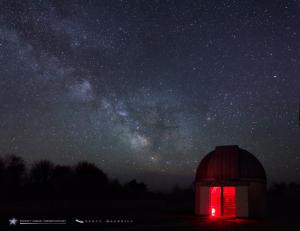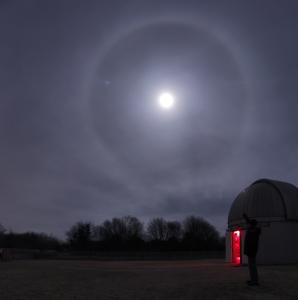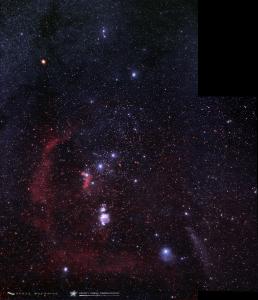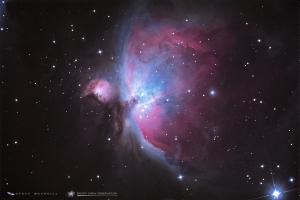
Stargazing Night
- Where:
- Frosty Drew Observatory
- When:
- Friday November 20, 2015 at 6:00 p.m.
- Cost:
- $1 Suggested Donation per Person
Tonight is Stargazing Night at Frosty Drew Observatory and skies look fabulous. We can expect clear skies, light winds, and cooler temps overnight. The 69% waxing gibbous Moon will be high in the sky at sunset offering up stunning views of the cratered lunar surface. The Moon will set just after 1:00 a.m. leaving super dark skies in its wake. Surely a spectacular night awaits for all who visit!
We will open the Observatory and Sky Theatre at 6:00 p.m. In the Observatory we will start off with views of the bright gibbous Moon. After which, binary stars, Uranus, and Neptune will be on display. Once the Moon sets, we will dive into a deep sky object frenzy, offering up stunning views of the vast Orion Nebula, the Flame Nebula and more. Inside the Sky Theatre temps, will be toasty warm with our popular astrophoto showcase on display. We will stay on site and open until either the skies or the pending dawn chase us out. Following Frosty Drew on Twitter (@FrostyDrewOBSY) or Facebook will get you our “Closing up” post when we decide to pack it in.
Tonight is the night to be out regardless if you are into the Moon or dark skies. The waxing gibbous Moon will be in an excellent phase to offer up totally stunning views of the Mare Imbrium region, which is where the best ray craters, and mountain ranges are found. Once the Moon sets, super dark skies will prevail and offer up chances to catch amazing views of the cosmos. So grab your jacket and hat, then head out to fabulous starscapes under the wide open, dark skies of Frosty Drew and connect with that inner astro-freak just waiting to break free.
-------------------------------------------------------------------------
Weekly Happenings
Scott MacNeill
Now that the cold nights are becoming frequent and the bright gibbous phases of the Moon are back, we have a high probability of stunning 22° lunar halo sightings. The halo around the Moon (and the Sun) forms from sunlight refracting twice through tiny hexagonal ice crystals in Earth's stratosphere. Refraction (the deflection of light as it passes through one transparent medium to another) happens first when entering the small hexagonal ice crystal and then again as it exits. This double refraction deflects sunlight a minimum of 22°, creating a visible halo with a 22° radius around the Sun or Moon. Since 22° is the minimum angle of deflection, inside the halo the sky will appear slightly darker. Rather unreliably, rumor has it that 22° halos are harbingers of winter storms, though a halo can easily form without any approaching storm. So a better indicator would be a forecast storm increasing the possibility of seeing a 22° halo. Best times to view the halo is when it is damp, hazy, and cold with a near full or full Moon. Catch a pic of a 22° halo? Post it on the Frosty Drew Observatory Facebook and we'll share it on our time line.
The Holiday Season is descending upon us in full swing snugly-puppy mode, bringing with it warm thoughts of seasonal festivities and cold nights reveling in the winter time starscape. With the frequent lapse in memory that winter actually happens in New England every year, we frequently think on winter in a negative context. Well we can either sit by the heater and cry about early sunsets, closed beaches, and frozen toes; or we can bundle up, dive in and see all the amazing things winter time has to offer. And what better way to welcome in the darker and colder side of the year, than with a mesmerizing view of the vast Orion Nebula in a large telescope under super dark skies.
Residing in the constellation Orion, the Orion Nebula is the closest star forming nebula to the Solar System. At a distance of around 1,500 light years, the nebula spans about 25 light years in diameter. Inside the wisps of hydrogen gas and star light, thousands of infant stars are just taking shape with unformed planetary systems about to set out on their own evolutionary story. The nebula is naked eye visible as the middle star in Orion's sword, making this one of two naked eye star forming nebulae in the Northern Hemisphere.
Each night we have been seeing the fabled constellation Orion rising higher and earlier. Becoming visible over the Eastern horizon just before 8:00 p.m., the views are becoming truly spectacular. Aside from the Orion Nebula, the constellation Orion has dozens of fabulous objects to view, from dense multiple star systems, to the huge Barnard's Loop, which is a possible super nova remnant that covers most of the Orion constellation. So make this a season to call in the winter with happy thoughts of ginger bread cookies, smoking bishop, wassailing, cozy snuggle times, and awesome winter time stargazing!
Happy Thanksgiving from all of us astro-geeks at Frosty Drew Observatory!
-Scott



